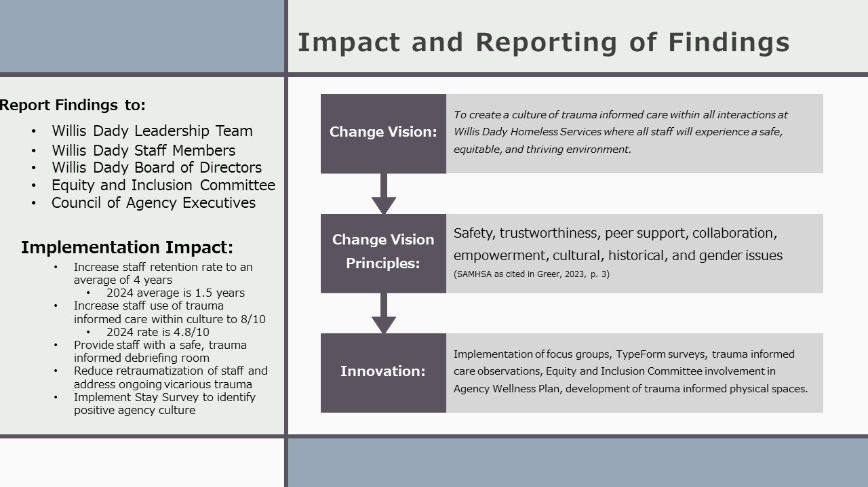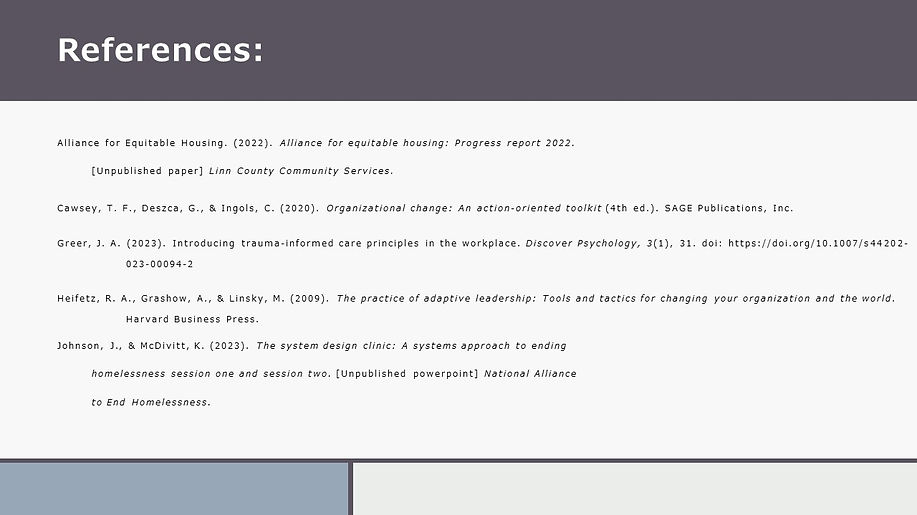Navigating Organizational Change & Innovation
Read my final proposal to support and encourage staff in leveraging their training in trauma informed care within their interactions with all people at our organization.




Stewarding the Balanced Scorecard is an area that has helped me become more of a visionary and an innovator as a leader. By being a steward of the balanced scorecard and resource management, I can lead organizational change, facilitate open and honest conversations, provide strategic and financial transparency, and uplift strengths of my team. Read more here about my journey with the balanced scorecard and my leadership development.
Force Field Analysis
There are many internal and external forces of change to consider within the scope of work we do at Willis Dady Homeless Services. As a homeless service agency, we provide key services outside of our main sheltering facility which we are primarily known for. We also provide street outreach, long term and short-term housing programs, affordable and supportive housing programs, homeless prevention assistance, Veteran housing services, and we operate an employment program. As all these programs have their own multitude of funding streams, a key external factor are our funders and grantors. I would consider them as the key entities that let our work happen as they fund what we can and cannot do within the parameters of each program. Although our funders and grantors are strong forces, they are not necessarily committed to Willis Dady directly, but committed to homeless service agencies who apply through a competitive grant application. If we do not meet key grant metric expectations and goals, the funding would go to another entity that had better outcomes.
Other external forces include other non-profit organizations, specifically other homeless service agencies that we partner with in our region and across the state. Through my experience, they help us accomplish our goals and we provide the same support. There are three key homeless service agencies in Cedar Rapids, Willis Dady, Waypoint Services, and Hawkeye Area Community Action Program (HACAP), and we all lift each other’s services up rather than challenge each other. We work together to provide the best referrals to individuals in need of homelessness and housing services to ensure that we are not duplicating the work that needs to be done in our community. Our community has great support for homeless services through our City and County staff and work together to find long-term solutions to the issue of homelessness. Just last summer, our The City of Cedar Rapids contracted with the National Alliance to End Homelessness to provide a county wide assessment of our homeless response system and with those results, are assisting in implementing their recommendations.
The forces who make it happen are our dedicated staff members and Board of Directors. Without the genuine commitment from our staff and board, we would not meet the goals set for us by our grantors, community, and within our own strategic plan. I have been with the organization since 2016 in many different capacities, most recently as Executive Director, so I have witnessed staff’s commitment to our cause and strength to overcome adversity directly on many occasions. According to an unpublished report by the Alliance for Equitable Housing (2022), homelessness has increased by over 200% in Linn County since 2019 (Alliance for Equitable Housing, 2022). This is a very concerning and daunting number, yet our staff continue to rise to the needs of those most vulnerable in our community to ensure everyone has access to housing and support through an array of wrap around services. Our administrative staff continue to show their commitment to our mission and vision by aligning with our values and best practices and doing the behind-the-scenes work that is necessary for us to meet our goals and vision.
These, and other forces, could be increased or changed by increasing our unrestricted revenue so we are not dependent on grant funding for certain programs. Recently, our Shelter Assistance Fund and Emergency Shelter Grant funding was cut due to state budget cuts. This cut could have led to the elimination of our shelter program entirely, yet we are committed to bringing our donors, faith-based organizations, corporations to the table to increase their annual giving to meet this budgetary need. We can also add forces in the realm of other non-profits outside of homeless services. In 2022 we partnered with Tanager Place to contract a therapist to provide individual therapy and group therapy sessions within our shelter and day center programs. This allows individuals direct access to mental health resources without needing to be on a waitlist or wait for their insurance to cover sessions. By lifting up the community non-profits doing the work that we recognize as a need, we can increase our external force field and bring new individuals to the table to address homelessness in our community.
The forces in place that oppose change within our organization are primarily the restrictions of our grant funding. With our primary funding being federal grants, there are many restrictions that come with administering that funding. For example, our Continuum of Care grant will cover the cost of case management but does not cover the cost of training case managers. Although the grant requires the case manager to be trained in best practices, we must use unrestricted funding to pay the cost of any training that is mandatory for the case manager to begin their role or continue their professional development. An internal force that impacts change is our inability to pay our staff a reasonable, living wage. As a non-profit organization, I know that Willis Dady is not the only entity that struggles with this. In 2022, I did an overhaul of our annual budget to raise the starting wage of all non-leadership level staff to $40,000 annually. Although that was a successful change, the cost of living continues to increase where now $40,000 annually is not livable and we are seeing our staff working multiple jobs or using state benefits to make ends meet.
To weaken or remove the forces that oppose change, I rely heavily on myself and my development department. For Willis Dady to not have as many grant restrictions in place and to not remain reliant on our grant funding, we need to increase our unrestricted revenue. We can continue working towards this goal by increasing our individual donors and stewarding existing donors who are already committed to our mission. We also accomplish this through increasing our revenue received through our two annual events and mid-year and end of year campaigns. This is also how we weaken the internal force by increasing our staff wages and maximize their benefits package. Not only will this allow staff to get a more livable wage, but also retain staff which will eliminate the barrier of staff turnover in the future
The key points of leverage include the work being done by the development department and increasing our external partnerships to other established non-profit organizations. In the start of this summary, I mentioned all the different programs Willis Dady is currently operating. Another point of leverage to advance change is to look at what we’re currently doing, and determining if we are the right entity to be doing this work. Eliminating roles and programs is not something I look forward to doing, yet if we are truly going to eliminate homelessness in our community, we need to ensure the right entity is doing the work. In fall 2023 after the National Alliance to End Homelessness provided their recommendations, Willis Dady, Waypoint, and HACAP directors had a meeting to discuss the regionalization of rapid rehousing funding. There was not enough funding in our region for all three entities to continue our programs, so I elected to eliminate our rapid rehousing program as we had the worst outcomes per the National Alliance report. This allowed two other entities who were running the program well, to continue their work, and allowed Willis Dady to focus our efforts on permanent supportive housing and street outreach, which we were doing well.
By taking a step back to evaluate the forces for change on an agency wide level, I can better determine the forces in play for individualized change as well as wide scale changes. This allows us to determine the best way to implement and advocate for change with all external and internal forces. It also allows us an opportunity to build more forces for change to continue working towards our mission and vision to eliminate homelessness in our community.
References
Alliance for Equitable Housing. (2022). Alliance for equitable housing: Progress report 2022.
[Unpublished paper] Linn County Community Services.